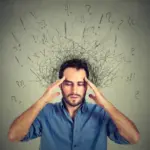
Thinking is considered one of the highest cognitive functions of the mind, that psychic activity that allows the evaluation of reality and the formulation of judgments, with the function of putting informative data in order, through processes of association, correlation , integration, abstraction and symbolization. Through thought we form ideas, concepts, imaginations, desires, criticisms, judgments, and it is possible to distinguish two types of thought disorders: formal ones and those related to the content of thought.
The disintegration of thought falls into the first category of formal disorders, represented precisely by alterations in the explanation of thought, and in this PsychologyFor article we will discuss the topic to understand What is the disintegration of thought, how the disintegration manifests itself and examples in this regard
What is thought
Treating thought disorders necessarily involves first trying to define what is meant by “thinking.” An arduous task, because thought seems to be defined as a omnipresent activity in human beings, as if it were a kind of a-priori of experience, which orders and makes the experience itself comprehensible. So much so that it is often said that “you can’t stop thinking”, and perhaps this is not really true, no matter how difficult it may seem at first glance to imagine “non-thinking”. So we could say that Thinking is analysis, judgment, relating things, reaching conclusions and solutions, knowing, but also imagining, fantasizing. to respond to internal emotional needs and not just to solve problems. In fact, along with logical-rational thinking, we have imaginative-fantastic thinking and intuitive thinking. Learn about the Types of thinking according to psychology here.
What is the disintegration of thought
Let’s look at the definition of the disintegration of thought. Is about a thought disorder, which consists of the inability to maintain a constant guiding idea, which results in incoherence and unproductiveness of thought It is characterized by the loss of control in the way impressions are perceived, whereby certain details are placed in the foreground, with the consequent fragmentation of the field of experience due to the elimination of higher orientations.
There is, then, a loss of the guiding idea as a consequence of the breakdown of normal associations, thoughts flowing without logical connection. The person slides from one topic to another, whether or not there may be an apparent relationship between them; Fragments may appear with no apparent relationship to each other, or a syntactic deformation that contains only a mixture of words or syllables, or a lack of coherence despite the existence of an acceptable grammatical construction.
Thought is not influenced by external stimuli and acquires an autonomous tone, and the final result is that the content becomes absurd, incomprehensible It occurs especially, but not exclusively, in schizophrenia.
This thought disorder appears in mental illness such as schizophrenia (especially hebephrenic and residual schizophrenia) or mania, and in cocaine or amphetamine intoxication.
In this article, you will find more information about thought disorders, such as flight of ideas, tangentiality of thought or bradypsychia.

Elements of thought disintegration
They are part of the disintegration of thought:
- The fusion or inclusion of heterogeneous facts, with the consequent folly of thought
- The digression in which the invasion of secondary thoughts ends up replacing the main thread.
- The omission or thought blocking, in which all main thought sequences are eclipsed even without the intervention of secondary thoughts.
- The madness in which an exchange is observed between thoughts referring to things and thoughts referring to one’s own inner world (delusional formations with a mixture and confusion of concepts are part of this area).
How the disintegration of thought manifests itself
It manifests itself with the reduction or loss of common associative links between individual ideas. It is a “disconnected”, “fragmentary”, “strange” thought, in which mental associations follow one another. In more serious cases, the flow of ideas can become totally incomprehensible, which is why a total disintegration of the course of thought, and therefore of language, is manifested into disconnected, fleeting fragments, which approach each other in an apparently random. Let’s look at some examples of thought disintegration:
- Mergers that is, meaningless concepts resulting from the condensation of two or more different ideas.
- Hyperinclusions that is, the insertion, in the course of a logical discourse, of a concept that is not appropriate or only marginally related.
- Neologisms (creation of new words).
- Symbolism when the person no longer uses words in the common sense, but with a personal meaning, sometimes difficult to understand by others.
- Cryptolalia and cryptography: as a consequence of symbolism and neologisms, language and writing can become incomprehensible, until reaching the so-called “word salad.”
This article is merely informative, at PsychologyFor we do not have the power to make a diagnosis or recommend a treatment. We invite you to go to a psychologist to treat your particular case.
If you want to read more articles similar to Disintegration of thought: what it is, how it manifests and examples we recommend that you enter our Clinical Psychology category.
Bibliography
- Fornaro, G. (2012). I will think and rave. Retrieved from: http://www.psychiatryonline.it/node/1245
- Galimberti, U. (2002). Psychology Dictionary. Cerro Del Agua: Siglo Veintiuno Editores.
- Papagni, S. (2021). Disturbi del Pensiero: eat riconoscerli. Retrieved from: https://sergiopapagni.it/blog/disturbi-del-pensiero-come-riconoscerli.html
- Pifarré, J. (2011). Thought and language disorders. Recovered from: https://www.pir.es/impugnaciones2018/pregunta77/cap45%20Trast%20PENSACIONES%20y%20LENGUAJE.pdf








